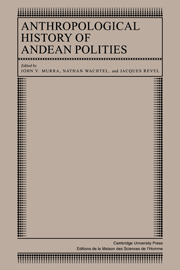Book contents
- Frontmatter
- Contents
- List of contributors
- Preface
- Introduction
- Part I Ecology and society
- Part II The ethnic group and the state
- 4 The expansion of the Inka state: armies, war, and rebellions
- 5 Storage, supply, and redistribution in the economy of the Inka state
- 6 The extraction of precious metals at the time of the Inka
- 7 Vertical politics on the Inka frontier
- Part III Systems of classification
- Part IV Symbolic representations and practices
- Part V From ethnic polities to communities
- Bibliography of published source
- Index
4 - The expansion of the Inka state: armies, war, and rebellions
Published online by Cambridge University Press: 05 October 2010
- Frontmatter
- Contents
- List of contributors
- Preface
- Introduction
- Part I Ecology and society
- Part II The ethnic group and the state
- 4 The expansion of the Inka state: armies, war, and rebellions
- 5 Storage, supply, and redistribution in the economy of the Inka state
- 6 The extraction of precious metals at the time of the Inka
- 7 Vertical politics on the Inka frontier
- Part III Systems of classification
- Part IV Symbolic representations and practices
- Part V From ethnic polities to communities
- Bibliography of published source
- Index
Summary
Some years ago the Swedish historian Ake Wedin urged us to reject Rowe's chronology of Inka expansion, which claimed that Cusco rule had expanded and was destroyed by the Europeans, all in less than one hundred years (Wedin 1963).
John Howland Rowe's evidence, marshaled more than thirty years ago, seemed convincing then, became the conventional wisdom, and continues to be persuasive (Rowe 1945). Many of us active in the Andes did wonder how such a vast polity, incorporating scores if not hundreds of separate ethnic groups, spread out over more than 4,000 kilometers, could have been welded together in less than a century. Wedin stressed the lack of any occidental precedent for such rapid expansion; he also voiced his skepticism at the claims of Inka oral dynastic tradition recorded less than twenty years after the European invasion.
An indispensable component of this incorporation has been stressed, if in preliminary form, by Paul Kirchhoff (1946). When undertaking the expansion, the kings of Tawantinsuyu, the Inka state, were heirs to an experience of statecraft going back centuries, if not millennia. Wari, Chimu, Tiwanaku – all were pre-Inka states, and archaeology gives us no reason to assume that even these were the earliest complex, stratified societies of the region. How to incorporate and then govern disparate linguistic and ethnic groups was part of the political repertoire of thousands of local Andean lords well before A.D. 1000.
- Type
- Chapter
- Information
- Anthropological History of Andean Polities , pp. 49 - 58Publisher: Cambridge University PressPrint publication year: 1986
- 24
- Cited by



